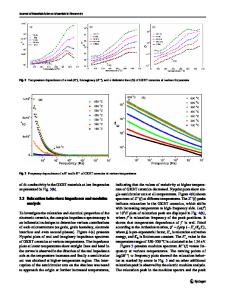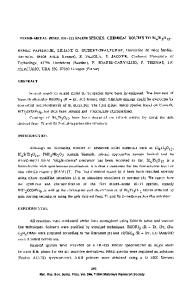Contrasting Structural Behavior in the Aurivillius Phase Ferroelectrics Bi 4 Ti 3 O 12 , BaBi 4 Ti 4 O 15 and Ba 2 Bi 4
- PDF / 356,884 Bytes
- 8 Pages / 612 x 792 pts (letter) Page_size
- 2 Downloads / 342 Views
DD4.7.1
Contrasting Structural Behavior in the Aurivillius Phase Ferroelectrics Bi4Ti3O12, BaBi4Ti4O15 and Ba2Bi4Ti5O18 Philip Lightfoot1, Alan Snedden1, Susan M. Blake1 and Kevin S. Knight2 1. School of Chemistry, University of St Andrews, St Andrews, Fife, KY16 9ST, UK; e-mail [email protected] 2. ISIS Facility, Rutherford Appleton Laboratory, Chilton, Didcot, OX11 0QX, UK. ABSTRACT The crystal structures of the Aurivillius phase ferroelectrics Bi4Ti3O12, BaBi4Ti4O15 and Ba2Bi4Ti5O18, containing perovskite-like layers consisting of three, four and five adjacent TiO6 octahedra, respectively, have been analysed using high-resolution powder neutron diffraction data. At 2K the structure of Bi4Ti3O12 can be successfully modelled in the orthorhombic space group B2cb, with no evidence of the monoclinic distortion in the ferroelectric phase suggested by previous single crystal studies. At 298K BaBi4Ti4O15 shows a subtle orthorhombic distortion, but without the octahedral tilting seen in related ferroelectric phases, and is refined in space group F2mm. At 298 K Ba2Bi4Ti5O18 adopts a tetragonal polar phase (I4mm), thus displaying a third type of polar distortion within this family. It is suggested that these differences arise from a ‘tolerance factor’ type mechanism whereby the increasing content of the large Ba2+ cation causes a shift from underbonding at the perovskite A-site to underbonding at the perovskite B-site resulting in a change in the mechanism of ferroelectricity from A-site displacements to B-site displacements, akin to the mechanism in BaTiO3. INTRODUCTION The Aurivillius family [1] of layered bismuth-containing oxides encompasses many ferroelectric materials [2], which have recently attracted considerable attention for use in FeRAM applications, due to their remarkable fatigue resistance [3,4]. Structurally, the Aurivillius phases may be considered as layered intergrowths of fluorite like [M2O2] units alternating with perovskitelike [An-1BnO3n+1] units to give a general composition M2An-1BnO3n+3, where M is generally Bi3+, A is a group II or lanthanide metal and B is a d0 transition element (Ti4+, Nb5+, Ta5+ etc.). For differing numbers of perovskite layers, n, typical Aurivillius phases are Bi2WO6 (n=1), SrBi2Ta2O9 (n=2), Bi4Ti3O12 (n=3), BaBi4Ti4O15 (n=4) and Ba2Bi4Ti5O18 (n=5). We have recently been studying the detailed crystallographic behaviour of these materials, in polycrystalline form, by powder neutron diffraction (PND) methods. In particular, the following generalisations have been established: (i) In agreement with the early hypothesis of Newnham [5] the ferroelectric phase incorporates ‘tilting’ of the BO6 octahedral units which lowers the symmetry from the archetypal paraelectric phase (tetragonal, I4/mmm) to an orthorhombic phase, the nature of which depends on the number, n, of octahedral layers; ‘even-layer’ systems, such as SrBi2Nb2O9 (n=2) [6] and SrBi4Ti4O15 (n=4) [7] adopt the space group A21am, whilst ‘odd-layer’ systems, specifically Bi4Ti3O12 (n=3) [8,9] adopt the space group B2cb (alt
Data Loading...










